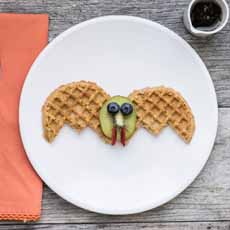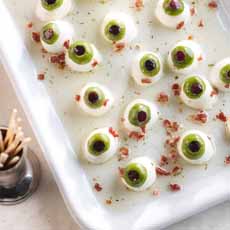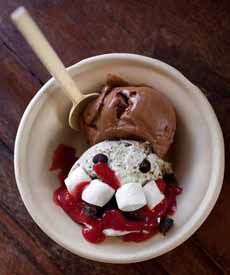TIP OF THE DAY: The History Of Halloween…And Fun Food Touches
 Try your hand at latte art. Here’s a video showing how to create a jack o’ lantern in milk foam (photo Fig & Olive | Facebook). Or, make a latte ghost.
[4] Vampire ice cream sundae, with strawberry topping, mini marshmallows and chocolate chip eyes (photo Hannah Kaminsky | Bittersweet Blog). |
DID YOU KNOW…
Halloween, short for All Hallows’ Evening, is celebrated on the evening of October 31st. It evolved from the festival of Samhain (sah-WEEN), celebrated by ancient Celts at the end of the harvest, a time to prepare for winter. Samhain marked the end of the “lighter half” of the year and beginning of the “darker half.” The Halloween colors of orange and black represent the lighter side and the darker side. The Celts believed that on October 31st, the boundaries between the worlds of the living and the dead overlapped and the deceased would come back to life and cause havoc, including sickness and damaged crops. To avoid the spirits and ghosts that roamed the countryside on October 31st, people began to wear masks and costumes—to mimic the spirits and avoid being recognized as human. To keep spirits and ghosts from their home, they placed candles in their windows, using hollowed-out turnips and other vegetables as the holder, or jack o’ lantern. The festival of Samhain would frequently include celebratory bonfires. The fires attracted insects, which attracted bats. Thus, bats became integrated into the holiday. Around 600 C.E., Christian missionaries replaced the pagan festival of Samhain with All Saints Day, also called All Hallows Even (even means evening). The name Halloween (or Hallowe’en) first appears in 16th-century Scotland, evolving from All Hallows’ Eve. Carving pumpkins into jack-o-lanterns, trick-or-treating, costume parties and visiting “haunted houses”—not to mention pranking—evolved in the U.S. Pumpkins, a hardier, new world fruit (yes, a fruit), replaced the smaller turnips used in the Old Country. It began with 19th-century Irish and Scottish immigrants who brought the tradition over. In the late 20th century, the “holiday spirit” spread to other western countries, including Australia, Canada, Ireland, New Zealand, Puerto Rico and the U.K. > More history of Halloween. No matter how you plan to celebrate Halloween, you can serve little touches of the holiday for the week prior to the event. Halloween is too much fun to wait for one day of celebration. You don’t have to be a kid to want an entire Halloween Week. If you need inspiration, check online sites like Pinterest or Google Images to see what others have done. > The history of Trick or Treating. |
|
|
CHECK OUT WHAT’S HAPPENING ON OUR HOME PAGE, THENIBBLE.COM. |
||





